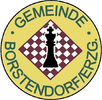Borstendorf
|
Borstendorf
Community Grünhainichen
|
||
|---|---|---|
| Coordinates: 50 ° 46 ′ 20 ″ N , 13 ° 10 ′ 41 ″ E | ||
| Height : | 454 m above sea level NN | |
| Area : | 14.52 km² | |
| Residents : | 1302 (December 31, 2014) | |
| Population density : | 90 inhabitants / km² | |
| Incorporation : | January 1, 2015 | |
| Postal code : | 09579 | |
| Primaries : | 037294, 03725 | |
|
Location of Borstendorf in Saxony |
||
Borstendorf has been part of the Grünhainichen municipality in the Erzgebirgskreis in Saxony (Germany) since January 1st, 2015 .
geography
Borstendorf is a Waldhufendorf . The western border of the place forms the Flöha . From there the place stretches in an easterly direction up to a height of around 500 m. The lowest point is the Flöha at 330 m. To the east of the village is the Röthenbacher Wald.
structure
In addition to the main town, the Floßmühle district is located on the Flöha. This arose from the former settlement around the raft place and the paper mill.
history
In 1369 the later desolation of Röthenbach (an outbuilding of Rauenstein Castle) was first mentioned in a document. Borstendorf was first mentioned in a document in 1378 as Borsindorf . The name probably goes back to the personal name Boreš (Borso).
With the Reformation in 1539 Borstendorf daughter church is the parish Waldkirchen . With the start of rafting on the Flöha, a raft place was set up around 1573 . A school is first mentioned around 1617.
Violin making developed in Borstendorf towards the end of the 17th century . In 1746 a stone bridge with two pillars is built over the Flöha. In 1820 the town council decided to build a new church. In 1845 the new toll village street Waldkirchner Eppendorfer Halbchausee was completed. Bostendorf has been a branch church of the Parish Grünhainichen since 1848. With the commissioning of the Reitzenhain – Flöha railway line in 1875, the community received a rail connection, and the mills on Floßplatz also received a siding. A new school building is inaugurated on July 13, 1893. The Borstendorf volunteer fire brigade was founded in 1897. In the years 1901/1902 an electricity plant was built for the raft mill on the Flöha. A public electricity network was installed in 1911/1912. In 1903 Borstendorf becomes an independent parish. In 1927 the newly built water pipeline was put into operation. A swimming pool was built in 1927/1928. Due to the numerous manufacturers of chessboards in the town, chess became a compulsory subject in the Borstendorfer school in 1937 .
In 1945 the largest resident company, the paper mill CG Schönherr, was expropriated and in 1946 the factory, the hydropower plant and the sawmill were dismantled as a reparation payment . In 1959 a village cinema was opened. During the Chess Olympiad in Leipzig in 1960, the chess village Borstendorf was represented with its own exhibition. In 1973 a ski tow lift was opened. In 1990/1991 a central sewage treatment plant was built. Borstendorf became a member of the Wildenstein administrative association in 2001 through the Chemnitz-Erzgebirge municipal area reform law. A unanimous resolution of the municipal council to withdraw from the administrative association Wildenstein and an integration into the municipality of Leubsdorf in the then Freiberg district in 2006 was unsuccessful. A citizens' initiative was then founded.
On January 1, 2015, the previous municipality of Borstendorf was incorporated into the municipality of Grünhainichen.
Population development
The following population figures refer to December 31st of the given year with the territorial status January 2007:
|
1982 to 1988
|
1989 to 1995
|
1996 to 2002
|
2003 to 2009
|
2010 to 2014
|
- Source: State Statistical Office of the Free State of Saxony
Memorials
Memorial stones on the town hall forecourt and on the cemetery ceremony hall remind of two unknown Jewish concentration camp inmates . Her grave and a stone cross are in the local cemetery .
politics
Municipal council
After the municipal council election on May 25, 2014 , the 10-seat council was composed as follows:
- SG Rotation Borstendorf e. V. (SGR): 6 seats
- Free Electoral Association Borstendorf (FWB): 4 seats
mayor
- 1990 to July 2008: Manfred Sieber (CDU)
- August 2008 to December 2014: Christel Rothamel (individual candidate)
Personalities
- Christian Friedrich Göthel (1804–1873), organ builder
- Ernst Georg August Baumgarten (1837–1884), forester and inventor
- Herbert Ender (1901 – after 1933), member of the Reichstag
- Karlheinz Wagner (* 1938), enduro athlete
- Stefan Semmler (* 1952), rower, four-time world champion and two-time Olympic champion
traffic
The Reitzenhain – Flöha (Flöhatalbahn) railway runs south and west of Borstendorf. With the Floßmühle stop and the Grünhainichen-Borstendorf train station, the place has two stops on the route. They are served by the Erzgebirgsbahn .
literature
- Borstendorf . In: August Schumann : Complete State, Post and Newspaper Lexicon of Saxony. 1st volume. Schumann, Zwickau 1814, p. 462 f.
- Richard Steche : Borstendorf. In: Descriptive representation of the older architectural and art monuments of the Kingdom of Saxony. 6th booklet: Amtshauptmannschaft Flöha . CC Meinhold, Dresden 1886, p. 46.
Web links
- Borstendorf in the Digital Historical Directory of Saxony
- Floßmühle in the Digital Historical Directory of Saxony
Individual evidence
- ↑ Ernst Eichler , Hans Walther (ed.): Historisches Ortnamesbuch von Sachsen , Berlin 2001, Volume I, p. 99, ISBN 3-05-003728-8
- ↑ StBA: Area changes in 2015
- ↑ Results of the 2014 municipal council elections





